Role of Flaxseed Gum and Whey Protein Microparticles in Formulating Low-Fat Model Mayonnaises
Abstract
:1. Introduction
2. Materials and Methods
2.1. Materials
2.2. Preparation of Whey Protein Microparticles (WPMs)
2.3. Scanning Electron Microscopy (SEM)
2.4. Particle Size Measurement
2.5. Mechanical Properties of Whey Protein Gels
2.6. Swelling Test
2.7. Preparation of Model Mayonnaises
2.8. Rheological Measurement
2.9. Instrumental Texture Measurement
2.10. Confocal Laser Scanning Microscopy
2.11. Stability Test
2.12. Sensory Evaluation
2.13. Statistical Analysis
3. Results and Discussion
3.1. Whey Protein Microparticle Properties
3.2. Rheology and Instrumental Texture of Model Mayonnaises
3.3. Sensory Texture of Model Mayonnaises
3.4. Correlation between Creaminess and Rheology/Instrumental Texture
4. Conclusions
Supplementary Materials
Author Contributions
Funding
Institutional Review Board Statement
Informed Consent Statement
Data Availability Statement
Conflicts of Interest
References
- Bray, G.; Popkin, B. Dietary fat intake does affect obesity! Am. J. Clin. Nutr. 1998, 68, 1157–1173. [Google Scholar] [CrossRef]
- Ma, Z.; Boye, J.I. Advances in the design and production of reduced-fat and reduced-cholesterol salad dressing and mayonnaise: A review. Food Bioprocess Technol. 2013, 6, 648–670. [Google Scholar] [CrossRef]
- Guo, Q.; Ye, A.; Bellissimo, N.; Singh, H.; Rousseau, D. Modulating fat digestion through food structure design. Prog. Lipid Res. 2017, 68, 109–118. [Google Scholar] [CrossRef]
- Guo, Q. Understanding the oral processing of solid foods: Insights from food structure. Compr. Rev. Food Sci. Food Saf. 2021, 20, 2941–2967. [Google Scholar] [CrossRef]
- Di Monaco, R.; Miele, N.A.; Cabisidan, E.K.; Cavella, S. Strategies to reduce sugars in food. Curr. Opin. Food Sci. 2018, 19, 92–97. [Google Scholar] [CrossRef]
- Nastaj, M.; Sołowiej, B.; Terpiłowski, K.; Mleko, S. Effect of erythritol on physicochemical properties of reformulated high protein meringues obtained from whey protein isolate. Int. Dairy J. 2020, 105, 104672. [Google Scholar] [CrossRef]
- Gao, H.; Ma, L.; Cheng, C.; Liu, J.; Liang, R.; Zou, L.; Liu, W.; McClements, D.J. Review of recent advances in the preparation, properties, and applications of high internal phase emulsions. Trends Food Sci. Technol. 2021, 112, 36–49. [Google Scholar] [CrossRef]
- Di Mattia, C.; Balestra, F.; Sacchetti, G.; Neri, L.; Mastrocola, D.; Pittia, P. Physical and structural properties of extra-virgin olive oil based mayonnaise. LWT-Food Sci. Technol. 2015, 62, 764–770. [Google Scholar] [CrossRef]
- Herald, T.J.; Abugoush, M.; Aramouni, F. Physical and sensory properties of egg yolk and egg yolk substitutes in a model mayonnaise system. J. Texture Stud. 2009, 40, 692–709. [Google Scholar] [CrossRef]
- Flamminii, F.; Di Mattia, C.D.; Sacchetti, G.; Neri, L.; Mastrocola, D.; Pittia, P. Physical and sensory properties of mayonnaise enriched with encapsulated olive leaf phenolic extracts. Foods 2020, 9, 997. [Google Scholar] [CrossRef] [PubMed]
- Olsson, V.; Håkansson, A.; Purhagen, J.; Wendin, K. The effect of emulsion intensity on selected sensory and instrumental texture properties of full-fat mayonnaise. Foods 2018, 7, 9. [Google Scholar] [CrossRef] [PubMed] [Green Version]
- Kadian, D.; Kumar, A.; Badgujar, P.C.; Sehrawat, R. Effect of homogenization and microfluidization on physicochemical and rheological properties of mayonnaise. J. Food Process Eng. 2021, 44, e13661. [Google Scholar] [CrossRef]
- Yesiltas, B.; García-Moreno, P.J.; Sørensen, A.-D.M.; Soria Caindec, A.M.; Hyldig, G.; Anankanbil, S.; Guo, Z.; Jacobsen, C. Enrichment of mayonnaise with a high fat fish oil-in-water emulsion stabilized with modified datem c14 enhances oxidative stability. Food Chem. 2021, 341, 128141. [Google Scholar] [CrossRef] [PubMed]
- Agyei-Amponsah, J.; Macakova, L.; DeKock, H.L.; Emmambux, M.N. Effect of substituting sunflower oil with starch-based fat replacers on sensory profile, tribology, and rheology of reduced-fat mayonnaise-type emulsions. Starch—Stärke 2021, 73, 2000092. [Google Scholar] [CrossRef]
- Akhtar, M.; Murray, B.S.; Dickinson, E. Perception of creaminess of model oil-in-water dairy emulsions: Influence of the shear-thinning nature of a viscosity-controlling hydrocolloid. Food Hydrocoll. 2006, 20, 839–847. [Google Scholar] [CrossRef]
- Liu, K.; Tian, Y.; Stieger, M.; van der Linden, E.; van de Velde, F. Evidence for ball-bearing mechanism of microparticulated whey protein as fat replacer in liquid and semi-solid multi-component model foods. Food Hydrocoll. 2016, 52, 403–414. [Google Scholar] [CrossRef]
- Upadhyay, R.; Chen, J. Smoothness as a tactile percept: Correlating ‘oral’ tribology with sensory measurements. Food Hydrocoll. 2019, 87, 38–47. [Google Scholar] [CrossRef]
- Le Calvé, B.; Saint-Léger, C.; Babas, R.; Gelin, J.-L.; Parker, A.; Erni, P.; Cayeux, I. Fat perception: How sensitive are we? J. Texture Stud. 2015, 46, 200–211. [Google Scholar] [CrossRef]
- Sarkar, A.; Kanti, F.; Gulotta, A.; Murray, B.S.; Zhang, S. Aqueous lubrication, structure and rheological properties of whey protein microgel particles. Langmuir 2017, 33, 14699–14708. [Google Scholar] [CrossRef]
- Liu, K.; Stieger, M.; van der Linden, E.; van de Velde, F. Effect of microparticulated whey protein on sensory properties of liquid and semi-solid model foods. Food Hydrocoll. 2016, 60, 186–198. [Google Scholar] [CrossRef]
- Torres, O.; Andablo-Reyes, E.; Murray, B.S.; Sarkar, A. Emulsion microgel particles as high-performance bio-lubricants. ACS Appl. Mater. Interfaces 2018, 10, 26893–26905. [Google Scholar] [CrossRef] [PubMed] [Green Version]
- Hu, J.; Andablo-Reyes, E.; Soltanahmadi, S.; Sarkar, A. Synergistic microgel-reinforced hydrogels as high-performance lubricants. ACS Macro Lett. 2020, 9, 1726–1731. [Google Scholar] [CrossRef]
- Liu, H.; Xu, X.M.; Guo, S.D. Rheological, texture and sensory properties of low-fat mayonnaise with different fat mimetics. LWT-Food Sci. Technol. 2007, 40, 946–954. [Google Scholar] [CrossRef]
- Stokes, J.R.; Boehm, M.W.; Baier, S.K. Oral processing, texture and mouthfeel: From rheology to tribology and beyond. Curr. Opin. Colloid Interface Sci. 2013, 18, 349–359. [Google Scholar] [CrossRef] [Green Version]
- de Vicente, J.; Stokes, J.R.; Spikes, H.A. Soft lubrication of model hydrocolloids. Food Hydrocoll. 2006, 20, 483–491. [Google Scholar] [CrossRef]
- Selway, N.; Chan, V.; Stokes, J.R. Influence of fluid viscosity and wetting on multiscale viscoelastic lubrication in soft tribological contacts. Soft Matter 2017, 13, 1702–1715. [Google Scholar] [CrossRef] [PubMed] [Green Version]
- Stokes, J.R.; Macakova, L.; Chojnicka-Paszun, A.; de Kruif, C.G.; de Jongh, H.H.J. Lubrication, adsorption, and rheology of aqueous polysaccharide solutions. Langmuir 2011, 27, 3474–3484. [Google Scholar] [CrossRef]
- Appelqvist, I.A.M.; Cochet-Broch, M.; Poelman, A.A.M.; Day, L. Morphologies, volume fraction and viscosity of cell wall particle dispersions particle related to sensory perception. Food Hydrocoll. 2015, 44, 198–207. [Google Scholar] [CrossRef]
- Malone, M.E.; Appelqvist, I.A.M.; Norton, I.T. Oral behaviour of food hydrocolloids and emulsions. Part 1. Lubrication and deposition considerations. Food Hydrocoll. 2003, 17, 763–773. [Google Scholar] [CrossRef]
- Blok, A.E.; Bolhuis, D.P.; Kibbelaar, H.V.M.; Bonn, D.; Velikov, K.P.; Stieger, M. Comparing rheological, tribological and sensory properties of microfibrillated cellulose dispersions and xanthan gum solutions. Food Hydrocoll. 2021, 121, 107052. [Google Scholar] [CrossRef]
- Li, Y.; Joyner, H.S.; Carter, B.G.; Drake, M.A. Effects of fat content, pasteurization method, homogenization pressure, and storage time on the mechanical and sensory properties of bovine milk. J. Dairy Sci. 2018, 101, 2941–2955. [Google Scholar] [CrossRef] [PubMed]
- He, Q.; Hort, J.; Wolf, B. Predicting sensory perceptions of thickened solutions based on rheological analysis. Food Hydrocoll. 2016, 61, 221–232. [Google Scholar] [CrossRef]
- Su, H.-P.; Lien, C.-P.; Lee, T.-A.; Ho, J.-H. Development of low-fat mayonnaise containing polysaccharide gums as functional ingredients. J. Sci. Food Agric. 2010, 90, 806–812. [Google Scholar] [CrossRef]
- Krzeminski, A.; Prell, K.A.; Busch-Stockfisch, M.; Weiss, J.; Hinrichs, J. Whey protein–pectin complexes as new texturising elements in fat-reduced yoghurt systems. Int. Dairy J. 2014, 36, 118–127. [Google Scholar] [CrossRef]
- Ribes, S.; Peña, N.; Fuentes, A.; Talens, P.; Barat, J.M. Chia (Salvia hispanica L.) seed mucilage as a fat replacer in yogurts: Effect on their nutritional, technological, and sensory properties. J. Dairy Sci. 2021, 104, 2822–2833. [Google Scholar] [CrossRef]
- Yildiz-Akgül, F. Enhancement of torba yoghurt with whey protein isolates. Int. J. Dairy Technol. 2018, 71, 898–905. [Google Scholar] [CrossRef]
- Nastaj, M.; Sołowiej, B.G.; Gustaw, W.; Peréz-Huertas, S.; Mleko, S.; Wesołowska-Trojanowska, M. Physicochemical properties of high-protein-set yoghurts obtained with the addition of whey protein preparations. Int. J. Dairy Technol. 2019, 72, 395–402. [Google Scholar] [CrossRef]
- Clare, D.A.; Lillard, S.J.; Ramsey, S.R.; Amato, P.M.; Daubert, C.R. Calcium effects on the functionality of a modified whey protein ingredient. J. Agric. Food Chem. 2007, 55, 10932–10940. [Google Scholar] [CrossRef]
- Phan-Xuan, T.; Durand, D.; Nicolai, T.; Donato, L.; Schmitt, C.; Bovetto, L. Tuning the structure of protein particles and gels with calcium or sodium ions. Biomacromolecules 2013, 14, 1980–1989. [Google Scholar] [CrossRef]
- Mehalebi, S.; Nicolai, T.; Durand, D. The influence of electrostatic interaction on the structure and the shear modulus of heat-set globular protein gels. Soft Matter 2008, 4, 893–900. [Google Scholar] [CrossRef]
- Hongsprabhas, P.; Barbut, S. Protein and salt effects on ca2+-induced cold gelation of whey protein isolate. J. Food Sci. 1997, 62, 382–385. [Google Scholar] [CrossRef]
- Ju, Z.; Kilara, A. Aggregation induced by calcium chloride and subsequent thermal gelation of whey protein isolate. J. Dairy Sci. 1998, 81, 925–931. [Google Scholar] [CrossRef]
- Shen, X.; Guo, Q. Fabrication of robust protein-based foams with multifunctionality by manipulating intermolecular interactions. Green Chem. 2021, 23, 8187–8199. [Google Scholar] [CrossRef]
- Valim, M.D.; Cavallieri, A.L.; Cunha, R.L. Whey protein/arabic gum gels formed by chemical or physical gelation process. Food Biophys. 2009, 4, 23–31. [Google Scholar] [CrossRef]
- Oztop, M.H.; Rosenberg, M.; Rosenberg, Y.; McCarthy, K.L.; McCarthy, M.J. Magnetic resonance imaging (mri) and relaxation spectrum analysis as methods to investigate swelling in whey protein gels. J. Food Sci. 2010, 75, E508–E515. [Google Scholar] [CrossRef] [PubMed]
- Fan, L.; Ge, A.; Chen, X.D.; Mercadé-Prieto, R. The role of non-covalent interactions in the alkaline dissolution of heat-set whey protein hydrogels made at gelation ph 2–11. Food Hydrocoll. 2019, 89, 100–110. [Google Scholar] [CrossRef]
- Chang, C.; Li, J.; Li, X.; Wang, C.; Zhou, B.; Su, Y.; Yang, Y. Effect of protein microparticle and pectin on properties of light mayonnaise. LWT-Food Sci. Technol. 2017, 82, 8–14. [Google Scholar] [CrossRef]
- Liu, J.; Shim, Y.Y.; Shen, J.; Wang, Y.; Ghosh, S.; Reaney, M.J. Variation of composition and functional properties of gum from six canadian flaxseed (Linum usitatissimum L.) cultivars. Int. J. Food Sci. Tech. 2016, 51, 2313–2326. [Google Scholar] [CrossRef]
- Janssen, A.M.; Terpstra, M.E.J.; De Wijk, R.A.; Prinz, J.F. Relations between rheological properties, saliva-induced structure breakdown and sensory texture attributes of custards. J. Texture Stud. 2007, 38, 42–69. [Google Scholar] [CrossRef]
- Bicerano, J.; Douglas, J.F.; Brune, D.A. Model for the viscosity of particle dispersions. J. Macromol. Sci. Polym. Rev. 1999, 39, 561–642. [Google Scholar] [CrossRef]
- Lopez, C.G.; Voleske, L.; Richtering, W. Scaling laws of entangled polysaccharides. Carbohydr. Polym. 2020, 234, 115886. [Google Scholar] [CrossRef] [PubMed]
- Ozer, B.H.; Bell, A.E.; Grandison, A.S.; Robinson, R.K. Rheological properties of concentrated yoghurt (labneh). J. Texture Stud. 1998, 29, 67–79. [Google Scholar] [CrossRef]
- Nasirpour-Tabrizi, P.; Azadmard-Damirchi, S.; Hesari, J.; Khakbaz Heshmati, M.; Savage, G.P. Production of a spreadable emulsion gel using flaxseed oil in a matrix of hydrocolloids. J. Food Process. Preserv. 2020, 44, e14588. [Google Scholar] [CrossRef]
- Dickinson, E. Hydrocolloids at interfaces and the influence on the properties of dispersed systems. Food Hydrocoll. 2003, 17, 25–39. [Google Scholar] [CrossRef]
- Fuhrmann, P.L.; Kalisvaart, L.C.M.; Sala, G.; Scholten, E.; Stieger, M. Clustering of oil droplets in o/w emulsions enhances perception of oil-related sensory attributes. Food Hydrocoll. 2019, 97, 105215. [Google Scholar] [CrossRef]
- Imai, E.; Hatae, K.; Shimada, A. Oral perception of grittiness: Effect of particle size and concentration of the dispersed particles and the dispersion medium. J. Texture Stud. 1995, 26, 561–576. [Google Scholar] [CrossRef]
- Breen, S.P.; Etter, N.M.; Ziegler, G.R.; Hayes, J.E. Oral somatosensatory acuity is related to particle size perception in chocolate. Sci. Rep. 2019, 9, 7437. [Google Scholar] [CrossRef]
- Hossain, M.K.; Keidel, J.; Hensel, O.; Diakité, M. The impact of extruded microparticulated whey proteins in reduced-fat, plain-type stirred yogurt: Characterization of physicochemical and sensory properties. LWT 2020, 134, 109976. [Google Scholar] [CrossRef]
- Dickinson, E. On the road to understanding and control of creaminess perception in food colloids. Food Hydrocoll. 2018, 77, 372–385. [Google Scholar] [CrossRef]
- Upadhyay, R.; Aktar, T.; Chen, J. Perception of creaminess in foods. J. Texture Stud. 2020, 51, 375–388. [Google Scholar] [CrossRef]
- Wagoner, T.B.; Çakır-Fuller, E.; Shingleton, R.; Drake, M.; Foegeding, E.A. Viscosity drives texture perception of protein beverages more than hydrocolloid type. J. Texture Stud. 2020, 51, 78–91. [Google Scholar] [CrossRef] [PubMed]
- Nishinari, K.; Fang, Y.; Rosenthal, A. Human oral processing and texture profile analysis parameters: Bridging the gap between the sensory evaluation and the instrumental measurements. J. Texture Stud. 2019, 50, 369–380. [Google Scholar] [CrossRef]
- Funami, T.; Nakauma, M. Instrumental food texture evaluation in relation to human perception. Food Hydrocoll. 2022, 124, 107253. [Google Scholar] [CrossRef]
- Conti-Silva, A.C.; Ichiba, A.K.T.; Silveira, A.L.d.; Albano, K.M.; Nicoletti, V.R. Viscosity of liquid and semisolid materials: Establishing correlations between instrumental analyses and sensory characteristics. J. Texture Stud. 2018, 49, 569–577. [Google Scholar] [CrossRef] [PubMed]
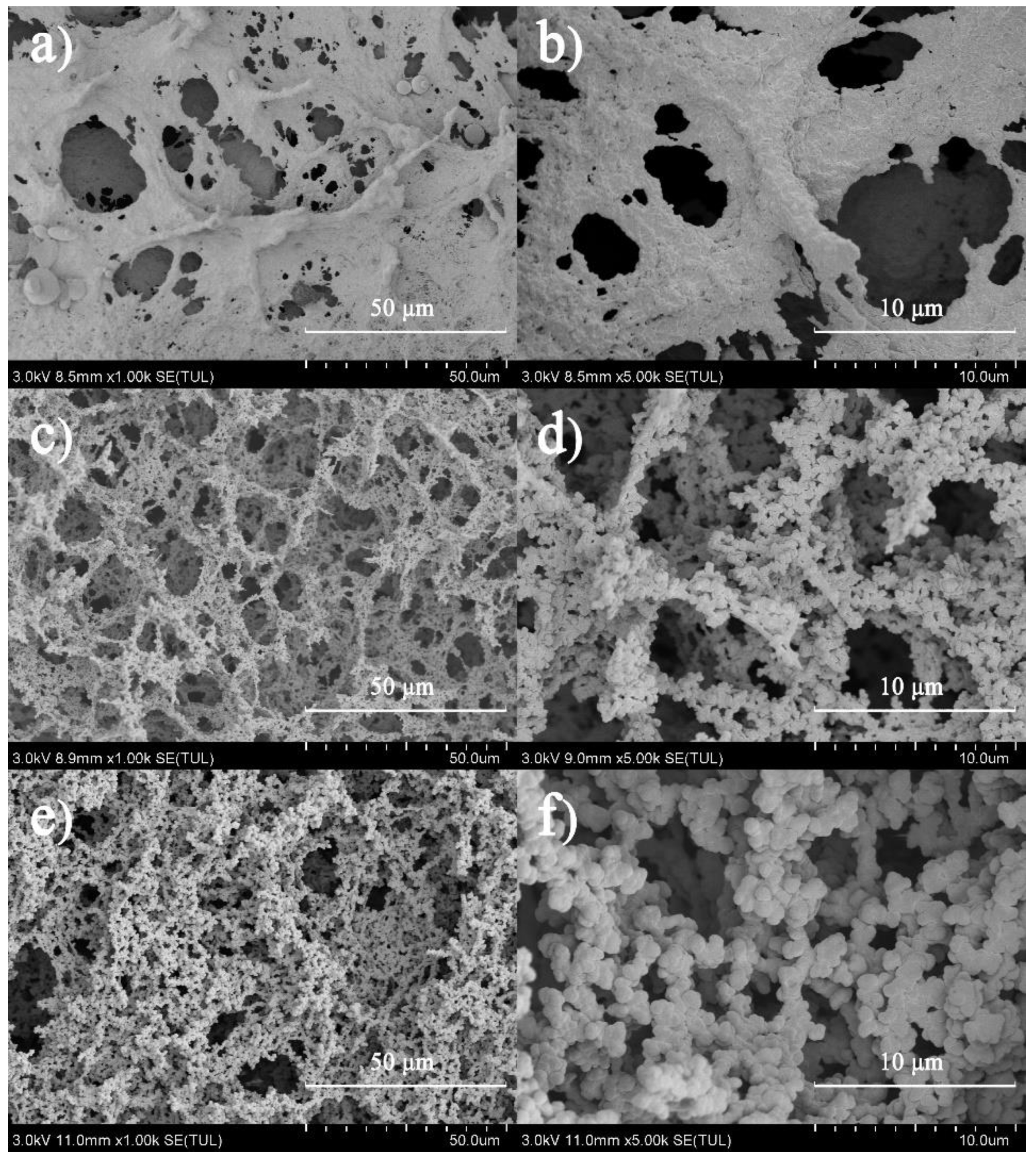


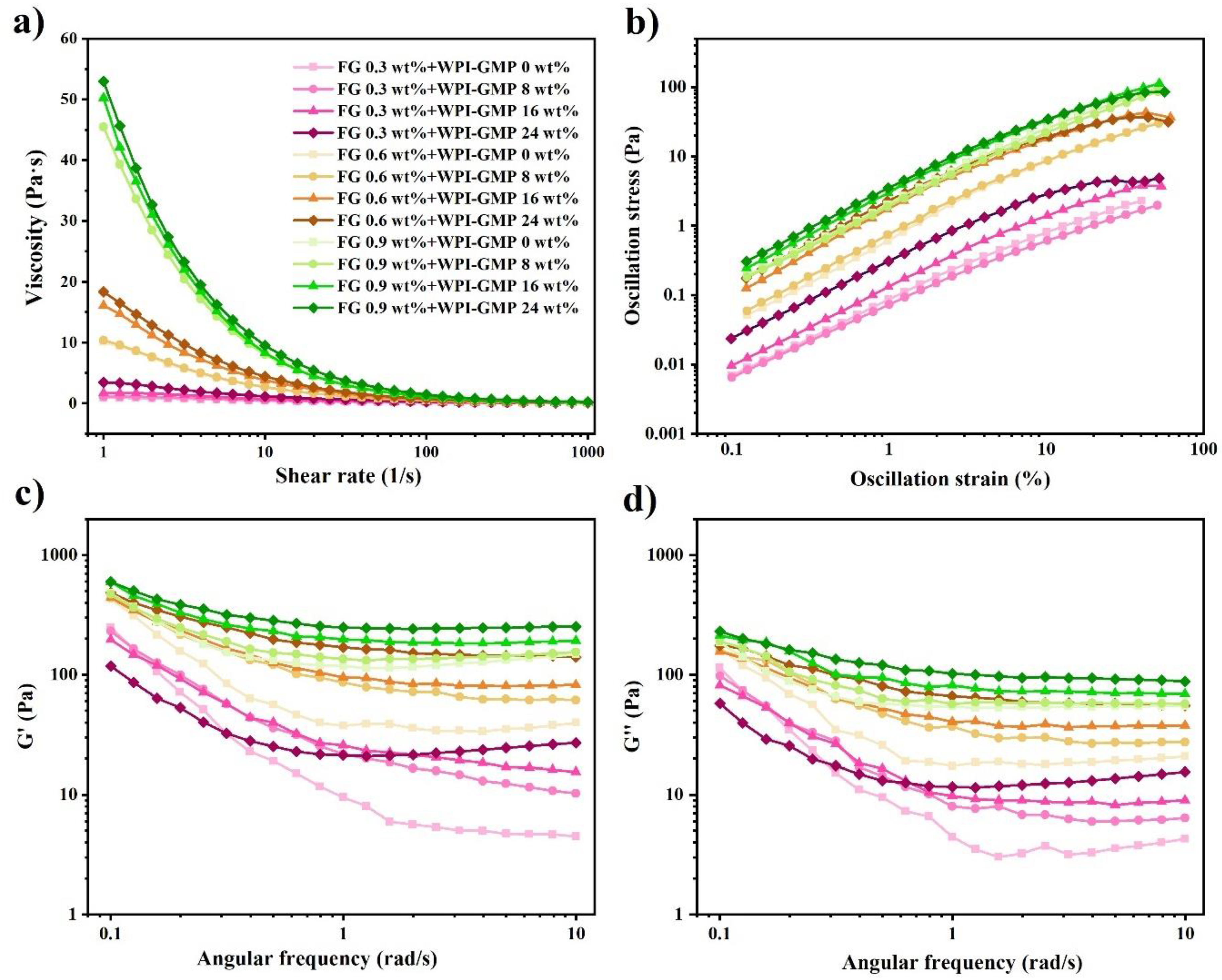
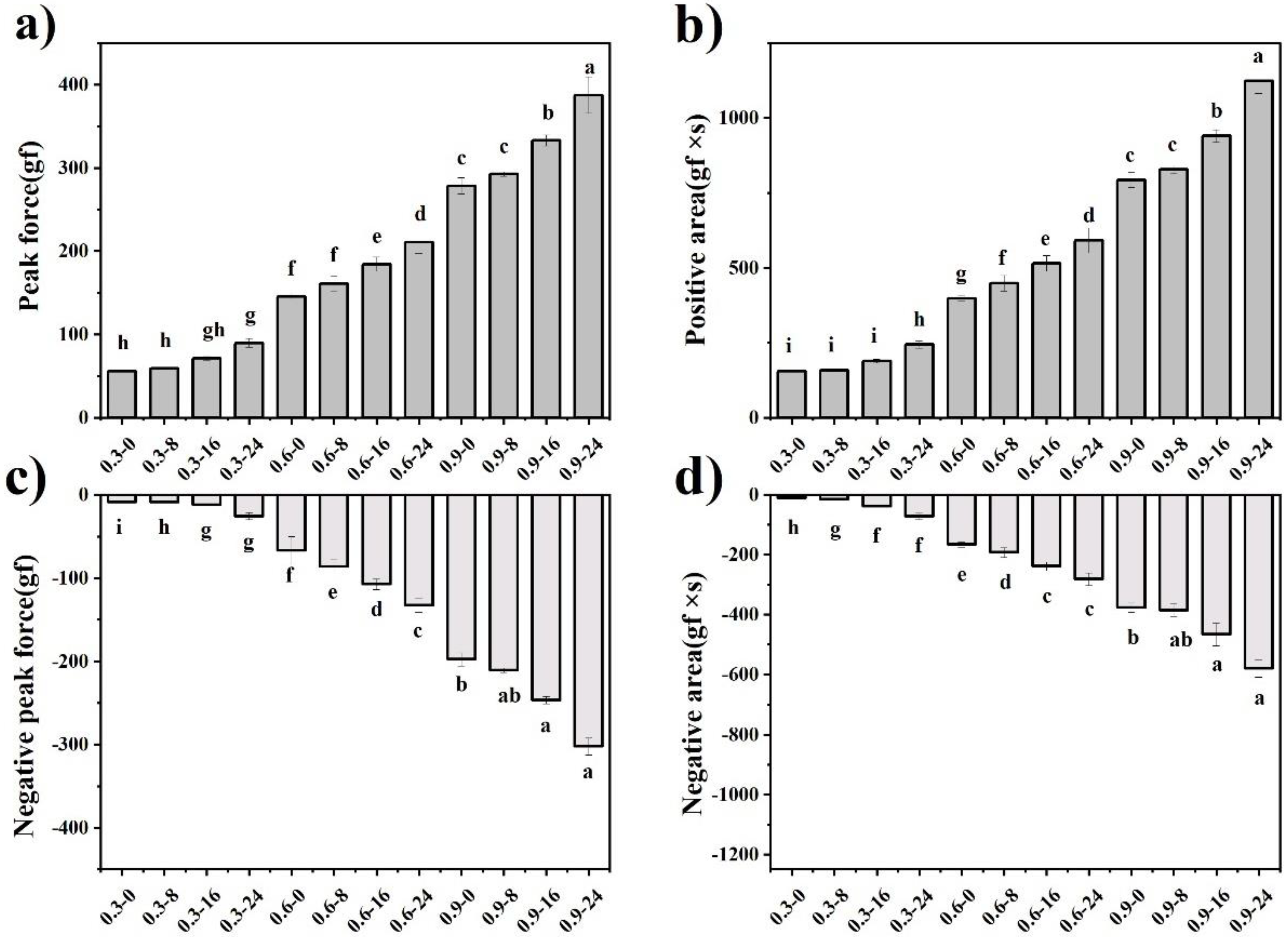
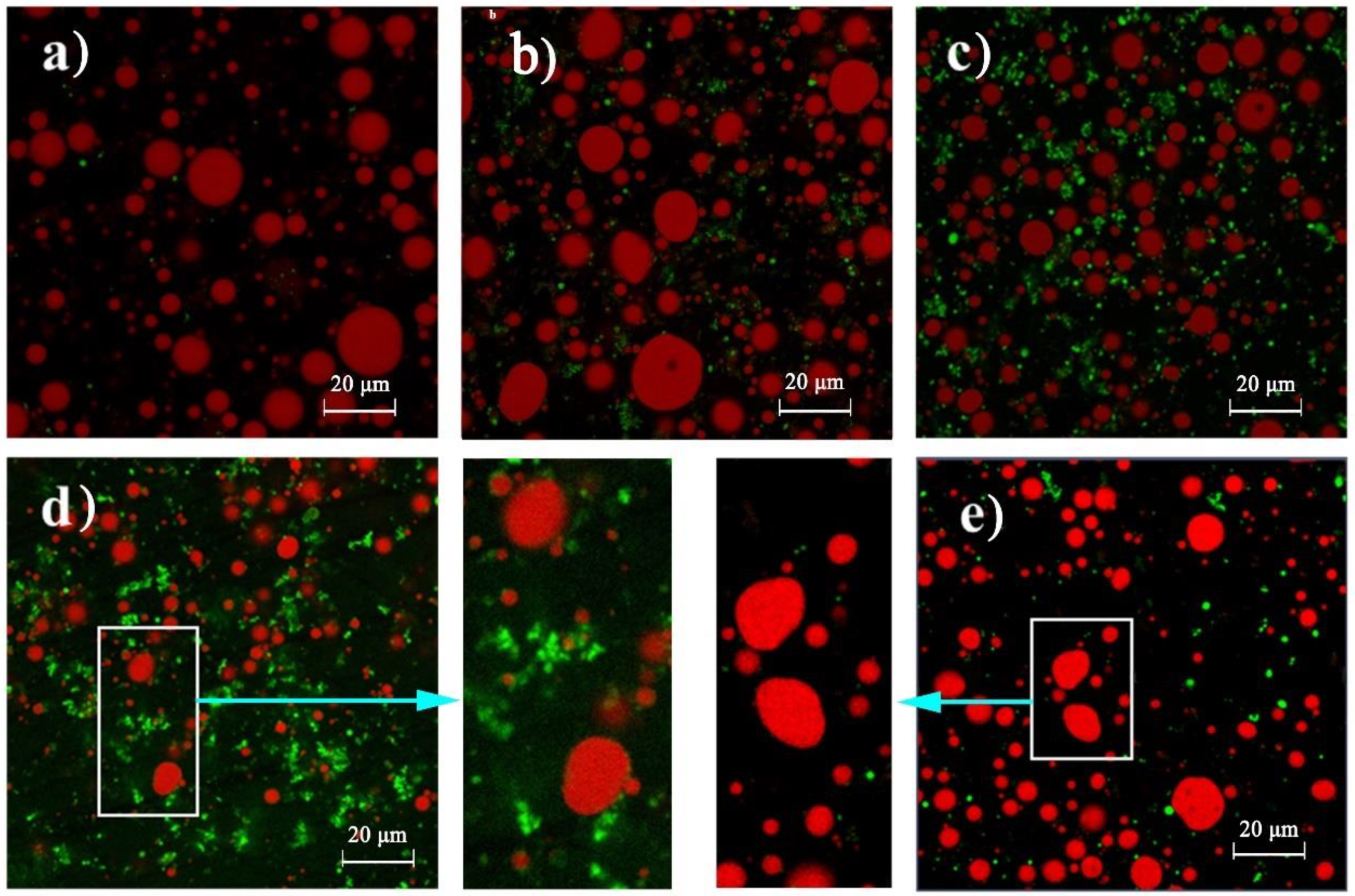
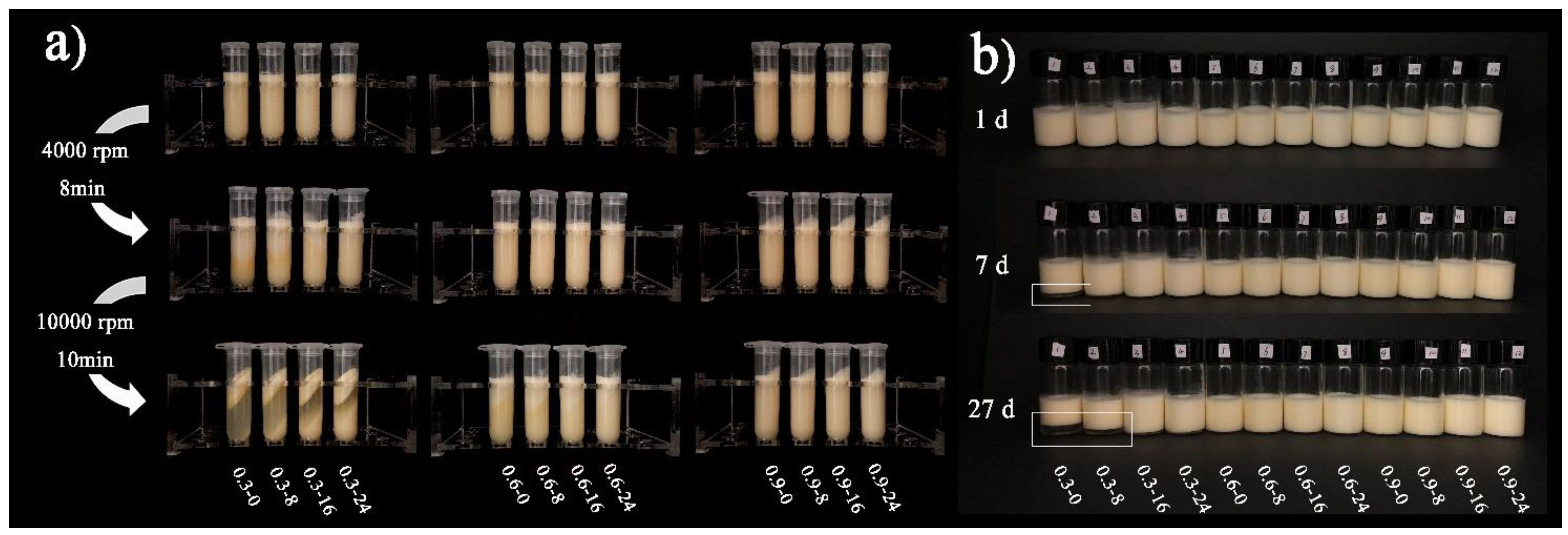
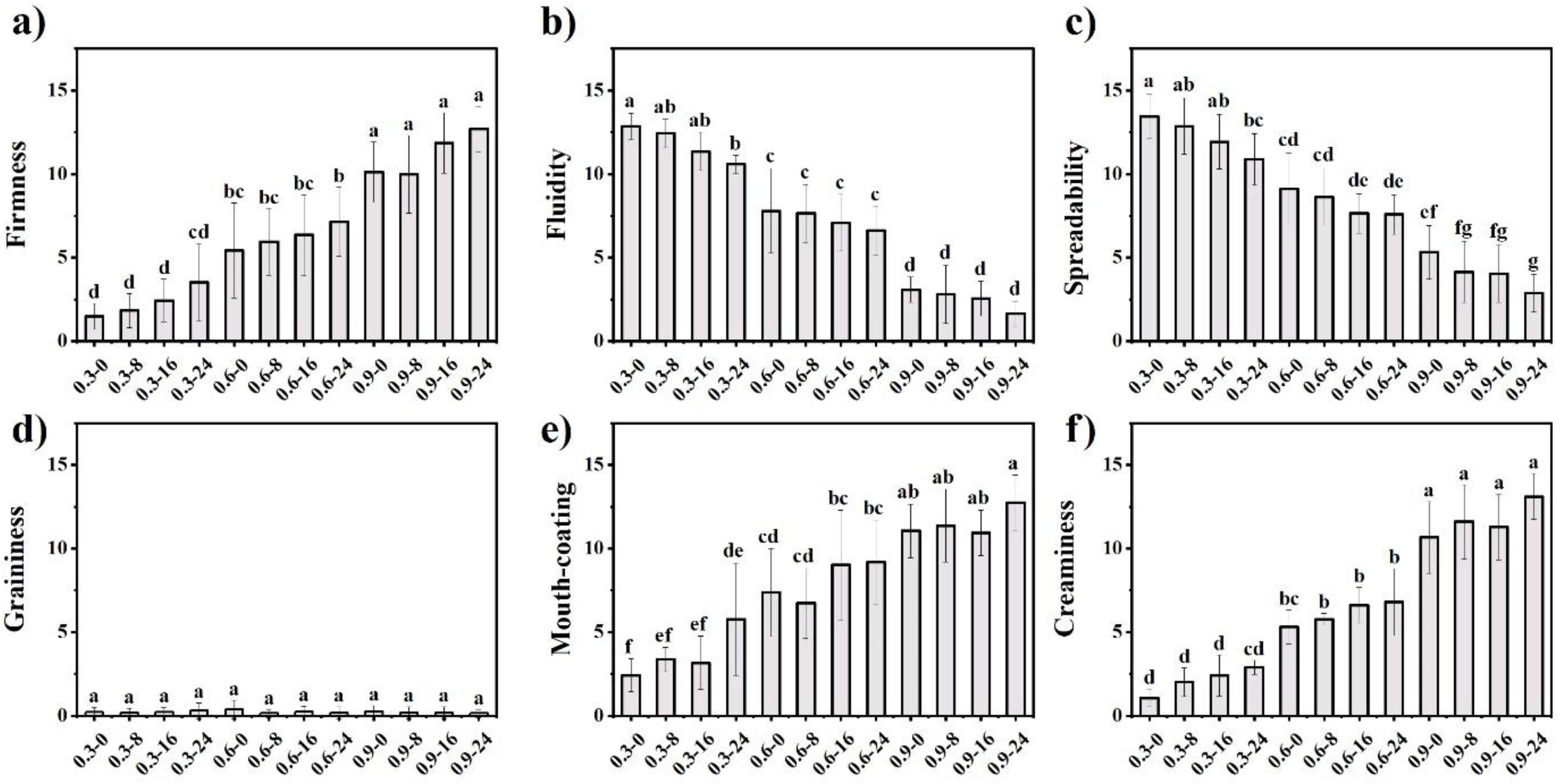
| Number of Sample | FG | WPM | Sucrose | Salt | Vinegar | Corn Oil | Dry Egg Yolk |
|---|---|---|---|---|---|---|---|
| wt% | wt% | wt% | wt% | wt% | wt% | wt% | |
| 0.3–0 | 0.3 | 0 | 5 | 0.5 | 4 | 15 | 4 |
| 0.3–8 | 0.3 | 8 | 5 | 0.5 | 4 | 15 | 4 |
| 0.3–16 | 0.3 | 16 | 5 | 0.5 | 4 | 15 | 4 |
| 0.3–24 | 0.3 | 24 | 5 | 0.5 | 4 | 15 | 4 |
| 0.6–0 | 0.6 | 0 | 5 | 0.5 | 4 | 15 | 4 |
| 0.6–8 | 0.6 | 8 | 5 | 0.5 | 4 | 15 | 4 |
| 0.6–16 | 0.6 | 16 | 5 | 0.5 | 4 | 15 | 4 |
| 0.6–24 | 0.6 | 24 | 5 | 0.5 | 4 | 15 | 4 |
| 0.9–0 | 0.9 | 0 | 5 | 0.5 | 4 | 15 | 4 |
| 0.9–8 | 0.9 | 8 | 5 | 0.5 | 4 | 15 | 4 |
| 0.9–16 | 0.9 | 16 | 5 | 0.5 | 4 | 15 | 4 |
| 0.9–24 | 0.9 | 24 | 5 | 0.5 | 4 | 15 | 4 |
| Stages | Attributes | Definitions |
|---|---|---|
| Texture (extra-oral) | Firmness | Degree of resistance when stirring with a spoon |
| Texture (intra-oral) | Fluidity | Degree of the sample flowing on the tongue |
| Spreadability | Degree of spreading the sample into a thin film by moving the tongue up and down against the palate | |
| Graininess | Extent of perception of particles when the tongue slides along the palate | |
| Mouth-coating | Degree of coating in the mouth after swallowing | |
| After-feel | Creaminess | Degree to which the sample leaves a soft, velvety, fatty feeling after swallowing. Creaminess is perceived in the whole mouth. |
| Extra-Oral | Intra-Oral | |||
|---|---|---|---|---|
| Creaminess | Firmness | Fluidity | Spreadability | Mouth-Coating |
| −0.986 ** | −0.994 ** | −0.992 ** | 0.970 ** | |
| Shear Rate (s−1) | R2 | Instrumental Texture | R2 |
|---|---|---|---|
| 1 | 0.977 ** | Hardness | 0.990 ** |
| 10 | 0.992 ** | Consistency | 0.988 ** |
| 100 | 0.992 ** | Adhesiveness | 0.985 ** |
| 1000 | 0.986 ** | Cohesiveness | 0.984 ** |
Publisher’s Note: MDPI stays neutral with regard to jurisdictional claims in published maps and institutional affiliations. |
© 2022 by the authors. Licensee MDPI, Basel, Switzerland. This article is an open access article distributed under the terms and conditions of the Creative Commons Attribution (CC BY) license (https://creativecommons.org/licenses/by/4.0/).
Share and Cite
Yang, K.; Xu, R.; Xu, X.; Guo, Q. Role of Flaxseed Gum and Whey Protein Microparticles in Formulating Low-Fat Model Mayonnaises. Foods 2022, 11, 282. https://doi.org/10.3390/foods11030282
Yang K, Xu R, Xu X, Guo Q. Role of Flaxseed Gum and Whey Protein Microparticles in Formulating Low-Fat Model Mayonnaises. Foods. 2022; 11(3):282. https://doi.org/10.3390/foods11030282
Chicago/Turabian StyleYang, Keying, Ruoting Xu, Xiyu Xu, and Qing Guo. 2022. "Role of Flaxseed Gum and Whey Protein Microparticles in Formulating Low-Fat Model Mayonnaises" Foods 11, no. 3: 282. https://doi.org/10.3390/foods11030282
APA StyleYang, K., Xu, R., Xu, X., & Guo, Q. (2022). Role of Flaxseed Gum and Whey Protein Microparticles in Formulating Low-Fat Model Mayonnaises. Foods, 11(3), 282. https://doi.org/10.3390/foods11030282






